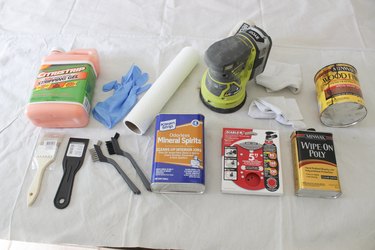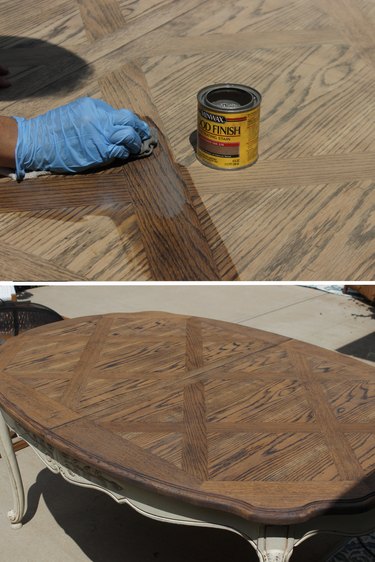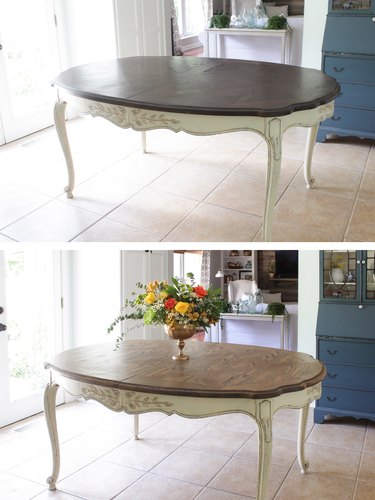
Got a wood dining table that needs a little TLC? Consider stripping and refinishing it. It'll give the table a gorgeous new look. Once you learn how to strip, sand, and stain your dining table — while maintaining the beauty of the wood — it'll last for future generations. Follow this step-by-step tutorial below.
Things You'll Need
Drop cloths
Stripping gel (non-toxic)
Rubber gloves
Chip brush
Plastic wrap (optional)
Plastic scraper
Paper towels
Small nylon brush
Small wire brush
Mineral spirits
Cotton rags, 3
Orbital sander
Sandpaper (120-, 220-, and 400-grit)
Wood conditioner
Oil-based wood stain
Oil-based wipe-on satin polyurethane finish
Video of the Day

1. Apply the stripping gel
Place a canvas or plastic drop cloths beneath the table. Using the chip brush, apply a generous amount of stripping gel across the entire surface of the table to properly dissolve the existing top coat finish. Let the gel sit for at least 30 minutes. If you want to let it sit for longer (that's a good idea if the current varnish or polyurethane top coat is thick), then cover the surface with plastic wrap so that the gel doesn't dry out. The stripping gel remains active for up to 24 hours, if sealed so it doesn't dry out.
Video of the Day

2. Remove the stripping gel and dissolved finish
Remove the plastic wrap, if it was applied, and place it in a paper bag for disposal. Using the plastic scraper, remove the stripping gel from the table top, scraping in the direction of the grain. Periodically clean the residue off the scraper by wiping it on paper towels. For edges or areas that are recessed, use a small nylon brush to get remove the stripping gel and dissolved finish. Once most of the stripping gel is removed, use a small wire brush to completely remove the remaining residue.

3. Clean residue with mineral spirits
Once all of the stripping gel has been removed, scrub the surface with mineral spirits and a cotton rag or scrubbing pad. Let the wood dry completely for a full 24 hours.
Tip
When all of the clear top coat is removed, the wood should have a grayish or a lighter hue across the entire surface, and feel dry and smooth. Some tables have a stubborn top coat or one with extra varnish. If so, Steps 2 and 3 will need to be repeated.

4. Sand the wood
Place the table in a well-ventilated area, such as an open garage or outdoors. Start sanding the table top using 120-grit sand paper. Make sure to move in the direction of the wood grain, or the sandpaper will make small scratch marks that will only be visible when the new stain is applied.
Tip
If the sandpaper is gumming up quickly with a dark residue, the stripper is still on the wood surface and will need to be removed using a scraping tool (you can use a metal one) or extra sandpaper disks.

Move the sander back and forth over the surface until the previous stain is removed and the wood color is a lot lighter. Do not be too concerned about getting the table to a uniform light wood color, as it is common for some stain to remain in the crevices of the wood grain. The color will balance out when you apply new stain. Once most of the stain is removed, feel the wood and notice the rougher texture. Use 220-grit sandpaper and go over the table top, moving back and forth in the same direction as the wood grain, until the entire surface is smooth to the touch.
Warning
Make sure to be patient when removing the stain on the wood: don't apply too much pressure to the sander or use a courser grit sandpaper in order to go faster. This can result in sanding too far into the wood—which will expose the composite wood underneath of your table is built with a wood veneer.
5. Apply a stain
First, rub wood conditioner onto the surface with a cotton rag. The conditioner prevents splotchiness, which is especially visible with darker stains. Next, apply the wood stain generously, rubbing it into the wood in the same direction as the grain. Let the stain sit for 10-30 minutes, until the desired tone is achieved, and wipe off the excess with a clean rag. Let the stain dry completely in a well-ventilated area for 8 hours.

6. Apply a clear top coat
Using a lint-free cotton cloth, apply a clear satin polyurethane finish by pouring a generous amount onto the rag or directly onto the table. Rub it into the wood by working in circular motions at first. Then, do a final "smooth over" in the direction of the grain. Let the finish dry for 8 hours, and then sand the surface very lightly with 400-grit sandpaper. Wipe the tabletop clean, then apply another coat of wipe-on polyurethane and wait 8 hours for it to dry. Repeat this process once or twice more, sanding lightly and wiping clean between coats, to achieve a durable and lasting satin finish.
7. Move your table back into position
Once the surface is dry, move the table back into your dining room. It's ready for whatever activity you and your family have in store!
